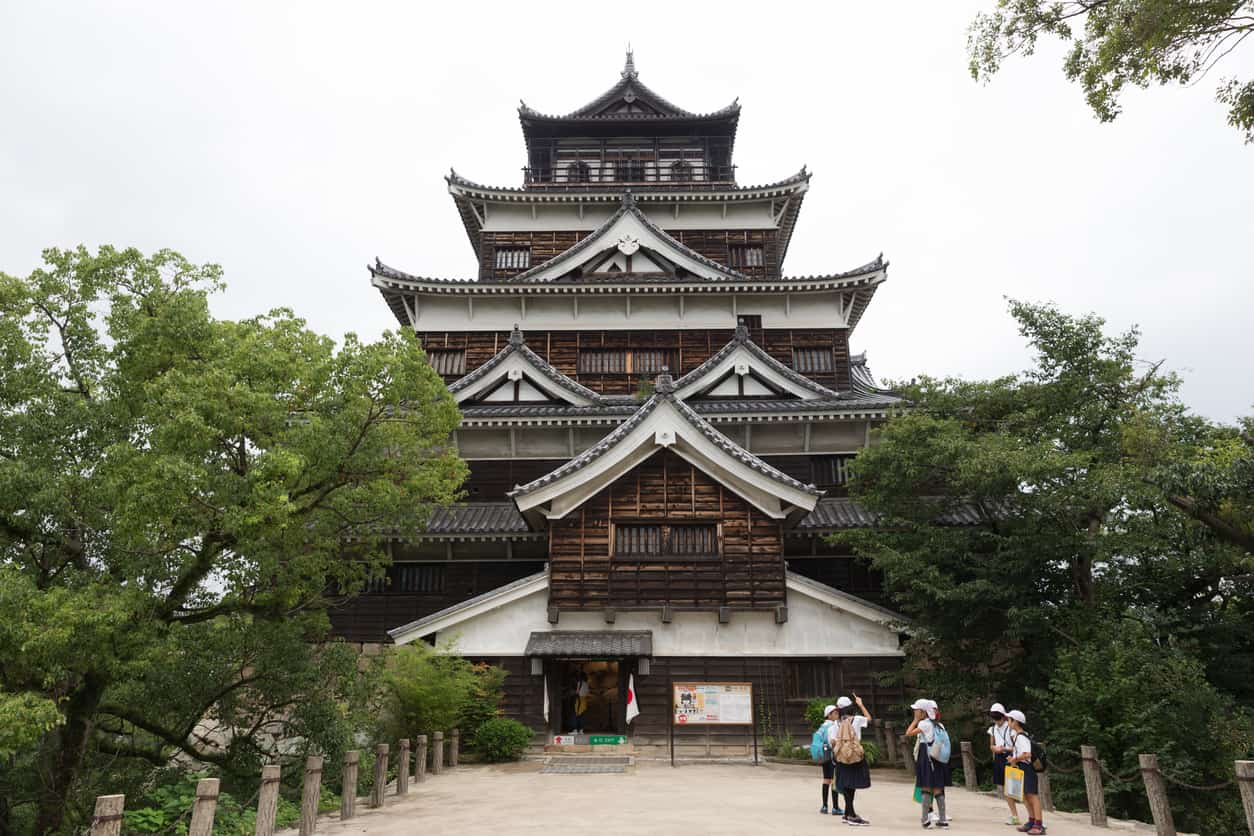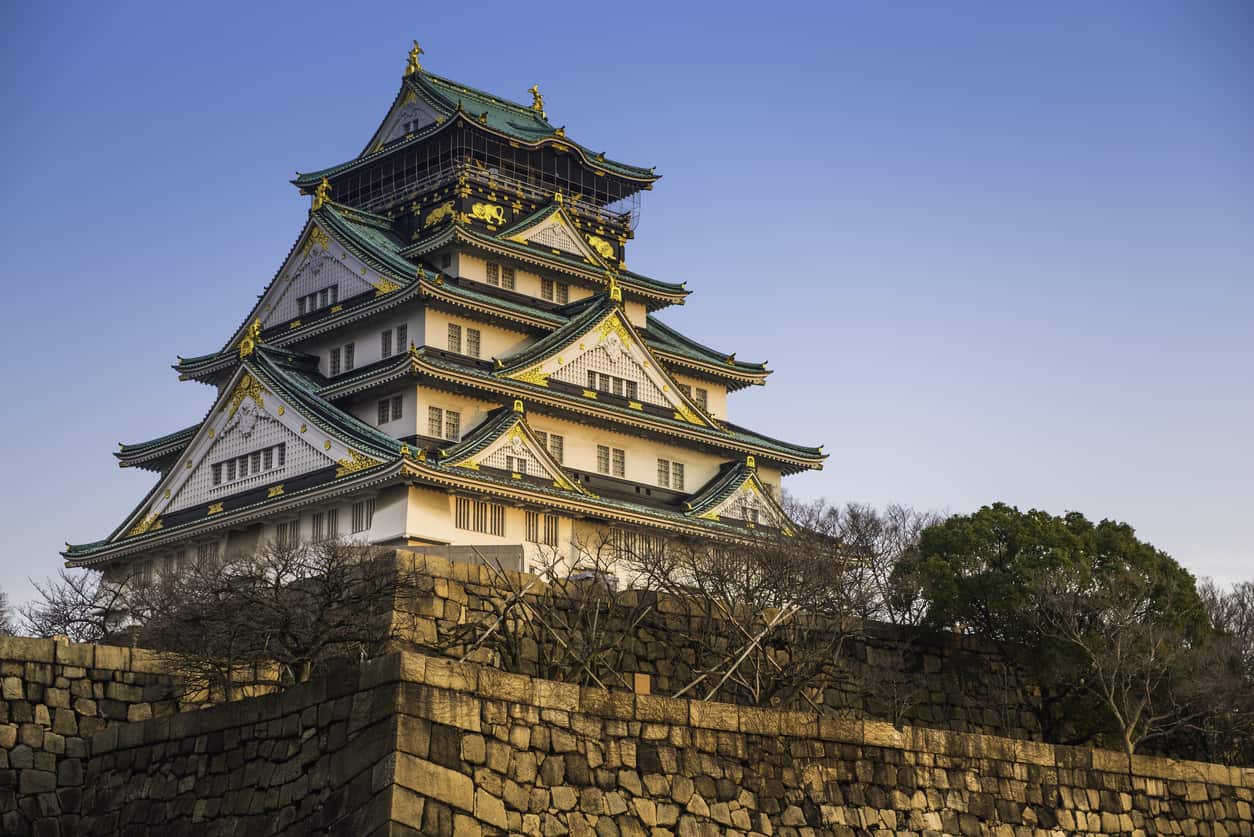
I’ve not been to Japan, but my wife has and she loved it. When I go, I hope to visit at least one of the these Japanese castles. As you can see the exteriors are fascinating and beautiful. I’m very curious as to what the interiors look like.
There are many levels to these imperial structures. The ornate curves combined with the symmetry makes for eye-pleasing buildings. I think you can agree with me that these are wonderful to look at and no doubt exciting to visit.
Related: Best Rhode Island Mansions | Things You Don’t Know about Alhambra Palace | Best Spanish Castles | Best Romania Castles
1. Echizen Ono Jo Castle

Ōno Castle, also known as Kameyama Castle is a yamashiro type or a mountain top castle located in Ōno (Former Echizen Province) Fukui Prefecture, Japan. The castle was built during the 16th century by Kanamori Nagachika, a samurai and a retainer to the powerful Daimyo, Oda Nobunaga when his lord placed him at the Echizen Province. The castle switched hands countless times and was destroyed but then rebuilt and is now open to public.
About the Ōno Castle
- Where: Ōno, Fukui Prefecture, Japan
- When: 16th Century
- Who built it: Kanamori Nagachika
- Style: Yamashiro / Japanese medieval architecture
- What is it now? Currently open to public
- Current owner: Japanese Government
2. Himeji Castle



Himeji Castle is a hilltop Japanese castle complex set in the city of Himeji in the Hyōgo Prefecture of Japan. It was originally built as a fort on top of Himeyama Hill by Akamatsu Norimura during the 14th century and was rebuilt later on to become the Himeji Castle. The castle underwent major transformation in 1581 up to 1618 and currently, it is open to public and is part of the UNESCO World Heritage Site.
About the Himeji castle
- Where: Himeji, Hyōgo Prefecture, Japan
- When: 14th Century
- Who built it: Akamatsu Norimura
- Style: Azuchi-Momoyama castle / Japanese medieval architecture
- What is it now? Part of the UNESCO World Heritage Site
- Current owner: Japanese Government
3. Hiroshima Castle

Hiroshima Castle, also known as Carp Castle was the home of the daimyō or feudal lord of the Hiroshima han. It was built in late 16th century by Mōri Terumoto, one of Toyotomi Hideyoshi’s council of Five Elders. Upon the Meiji Restoration, the castle came to serve as a military facility, but was destroyed during the final stage of World War II by the United States.
About the Hiroshima Castle
- Where: Hiroshima, Japan
- When: 16th Century
- Who built it: Mōri Terumoto
- Style: Azuchi-Momoyama castle / Japanese medieval architecture
- What is it now? Currently serves as a Museum
- Current owner: Japanese Government
4. Imabari Castle

Imabari Castle is popular as one of the three Mizujiro, or “Castles on the sea”, located in Imabari, Japan. Constructed by a local daimyō named Tōdō Takatora in the early 17th century, the castle went on to serve the rulers of the area for Edo period. Today, it is under the governance of Imabari City and is open to public and a known museum at the same time.
About the Imabari Castle
- Where: Imabari, Japan
- When: 17th Century
- Who built it: Tōdō Takatora
- Style: Japanese medieval architecture
- What is it now? Currently serves as a Museum
- Current owner: Japanese Government
5. Kōchi Castle

Kōchi Castle is located in Kōchi, Kōchi Prefecture, Japan and was built after the Battle of Sekigahara in 1600. Constructed by Yamanouchi Kazutoyo, the castle underwent many changes and even got reconstructed in its original style. It is currently open to public operated by Kochi Prefecture.
About the Kochi Castle
- Where: Kōchi, Kōchi Prefecture, Japan
- When: 17th Century
- Who built it: Yamanouchi Kazutoyo
- Style: Hirayamashiro / Japanese medieval architecture
- What is it now? Open to public
- Current owner: Japanese Government
6. Kokura Castle

Kokura Castle is located in Kitakyushu, Japan constructed by Hosokawa Tadaoki in the early 17th century. It became the property of the Ogasawara clan between 1632 and 1860. It was destroyed during the war between the Kokura and Chōshū clans then got fully restored in 1990 followed by the opening of the Seichō Matsumoto museum and castle garden were opened in 1998.
About the Kokura Castle
- Where: Kitakyushu, Japan
- When: 17th Century
- Who built it: Hosokawa Tadaoki
- Style: Japanese medieval architecture
- What is it now? Open to public
- Current owner: Japanese Government
7. Matsumoto Castle

Located in Matsumoto in Nagano Prefecture, Japan, Matsumoto Castle is one of Japan’s premier historic castles, along with Himeji Castle and Kumamoto Castle. It feature black exteriors, giving the name “Crow Castle” to it. The castle was built by Shimadachi Sadanaga of the Ogasawara clan in the early 16th century and went on to be ruled by the 23 lords of Matsumoto representing six different daimyō families.
About the Matsumoto Castle
- Where: Matsumoto, Japan
- When: 16th Century
- Who built it: Shimadachi Sadanaga of the Ogasawara clan
- Style: Japanese medieval architecture
- What is it now? One of Japan’s National Treasure
- Current owner: Japanese Government
8. Kumamoto Castle

Located in Chūō-ku, Kumamoto in Kumamoto Prefecture, Kumamoto Castle is a hilltop Japanese castle and is considered one of the three premier castles in Japan along with Himeji Castle and Matsumoto Castle. It was built in 1467 established by Ideta Hidenobu originally as fortifications and later on got expanded and reconstructed. Although it is open to public now, repair and restoration of the castle is still on going due to the damage it suffered from the earthquake.
About the Kumamoto Castle
- Where: Chūō-ku, Kumamoto, Kumamoto Prefecture
- When: 15th Century
- Who built it: Ideta Hidenobu
- Style: Japanese medieval architecture
- What is it now? Open to the public
- Current owner: Japanese Government
9. Nagoya Castle

Built in the early 17th century by Ieyasu Tokugawa in order to secure an important trade routes, the Tōkaidō and the Nakasendō, Nagoya Castle has been the home of Tokugawa family up until Meiji Restoration. During the World War 2, the castle was destroyed due to air raids on Nagoya, however, it was reconstructed and is now open to public under the city of Nagoya.
About the Nagoya Castle
- Where: Nagoya, Japan
- When: 15th Century
- Who built it: Ieyasu Tokugawa
- Style: Flatland castle / Japanese medieval architecture
- What is it now? Open to the public
- Current owner: Japanese Government
10. Shuri Castle

Shuri Castle is a Ryukyuan gusuku in Shuri, Okinawa that was built in the 15th century by the leaders of Chūzan to serve as the palace of the Ryukyu Kingdom. It was neglected for a long period of time and in 1945, in the Battle of Okinawa during the World War 2, it was almost completely destroyed and got controled by the U.S. Government. Now, it was successfully reconstructed and is a part of UNESCO World Heritage Site.
About the Shuri Castle
- Where: Shuri, Okinawa, Japan
- When: 15th Century
- Who built it: Kings of Chūzan
- Style: Gusuku / Japanese medieval architecture
- What is it now? Open to the public / UNESCO World Heritage Site
- Current owner: Japanese Government
11. Osaka Castle

Osaka Castle is one of Japan’s most famous landmarks and it played a major role in the unification of Japan during the sixteenth century of the Azuchi-Momoyama period located in Chūō-ku, Osaka, Japan. It was built following the orders of Hideyoshi Toyotomi in the 16th century modeled after Nobunaga Oda’s Azuchi Castle. After the loss of Toyotomi Clan against the Tokugawa clan, the castle was destroyed and rebuilt under the Tokugawa. Today, the castle is open to the public and is a popular spot during festival seasons.
About the Osaka Castle
- Where: Chūō-ku, Osaka, Japan
- When: 16th Century
- Who built it: Hideyoshi Toyotomi
- Style: Japanese medieval architecture
- What is it now? Open to the public / Popular tourist site
- Current owner: Japanese Government
12. Shimabara Castle

Shimabara Castle holds various names such as Moritake Castle and Takaki Castle. It is a Hira-style Japanese castle located in Shimabara, Hizen Province (Nagasaki Prefecture) built by Matsukura Shigemasa, the person who strictly enforced the prohibition against Christianity with mass executions. During the Meiji Restoration, the castle fell into the hands of the local government and became their seat. Now, Shimabara Castle is listed one of the 100 Fine Castles of Japan by the Japan Castle Foundation and is open to the public.
About the Shimabara castle
- Where: Shimabara, Hizen Province, Japan
- When: 16th Century
- Who built it: Matsukura Shigemasa
- Style: Hira style / Japanese medieval architecture
- What is it now? Open to the public / Popular tourist site / Museum
- Current owner: Japanese Government
13. Sunpu Castle

Sunpu Castle in Aoi-ku, Shizuoka, Shizuoka prefecture, Japan is a Hirayama-style Japanese castle built by Tokugawa Ieyasu in 1589. He lived at the castle in 1586, along with his first consort and trusted confidante, Lady Saigō, and their two sons, Hidetada and Tadayoshi. Today, the castle is in the hands of the city government and is open to the public.
About the Sunpu Castle
- Where: Aoi-ku, Shizuoka, Shizuoka prefecture, Japan
- When: 16th Century
- Who built it: Tokugawa Ieyasu
- Style: Hirayama style / Japanese medieval architecture
- What is it now? Open to the public
- Current owner: Japanese Government
14. Wakayama Castle


Set at the mouth of the Kii River, Wakayama Castle, originally named Ōta castle was the home of the Saiga Ikki before it was captured by Toyotomi Hideyoshi in 1585. It was built to serve as a temple for the Shushin branch of Japanese Buddhism and later on reconstructed by Toyotomi Hidenaga to become the known Wakayama Castle. Today, it serves as the symbol of the city and historical site and is open to the public.
About the Wakayama Castle
- Where: Wakayama, Wakayama Prefecture, Japan
- When: 16th Century
- Who built it: Toyotomi Hidenaga
- Style: Hirayamashiro style / Japanese medieval architecture
- What is it now? Open to the public / Historical site
- Current owner: Japanese Government
Related: English Castles | Irish Castles | German Castles | Russian Palaces | French Chateaus | Scottish Castles | Dutch Castles | Polish Castles | Czech Republic Castles | Hungarian Castles | Belgian Castles | Austrian Castles | Swedish Castles | Mountain-Top Castles | Palaces in India | Castles in Switzerland | Italian Castles | Castles in Romania | Castles in Denmark | Spanish Castles






